INTRODUCTION
Food records are used to assess the food intakes of free-living individuals. A perceived strength of food records is that the bias due to memory is minimal if the participant records foods immediately after intake [
1]. However, knowledge of recording food intake in the near future may influence the participant to alter one's diet to simplify the task of recording foods. Although the 24-h recall method can resolve this issue, it requires assistance from an interviewer or an automated software, which may increase the number of required resources. In addition, bias may be introduced by the interviewer or software. Misreporting of dietary intake occurs in both food records and 24-h recalls, with a greater discrepancy from actual intake observed in the latter method [
234]. Therefore, food records may be an economic and more effective tool to evaluate dietary intake if performed properly.
The validity of dietary assessment, including food records and 24-h recalls, has been studied in various populations, such as those in the US, the UK, and Belgium [
345678], but few validation studies have been performed in Korea. The results of previous validation studies are not applicable to Korea as Korean food culture drastically differs from those of Western countries. For instance, Korean meals traditionally consist of rice, soup, kimchi, sauces, and side dishes. Most side dishes are shared rather than served individually. No studies have assessed the validity of food records in Korea, and few studies have assessed the accuracy of 24-h recalls in Koreans [
910]. Recently, the accuracy was tested in older Korean men and women using the doubly labeled water method for reported energy intake [
910], but not for other nutrients or food groups. Dietary patterns and food intake, in addition to nutrient intake, are important in nutrition research but the accuracy of food records according to food groups has not been assessed in Koreans. In addition, previous studies in Western countries have shown that participants easily omit snacks and condiments [
1], but the accuracy of food records according to type of dish in Korean meals has not been investigated. Therefore, investigation of the validity of food records according to type of dish and food group is required to improve the accuracy of diet assessment in Koreans.
Owing to the lack of studies validating dietary intake assessment in Koreans, we assessed the accuracy of food item and portion size estimation of estimated food records according to food group and type of dish in the Korean diet, and the effect of a short education session aimed to improve food record accuracy in young Korean women.
DISCUSSION
Through a controlled-feeding study design, we assessed the validity of food records and the effect of a short education session on food records in young Korean women. Prior to education, the participants accurately reported 81% of the food items, but the precision of portion size estimation was low. The accuracy of reporting food items was not dramatically affected by the education provided, but portion size estimation drastically improved.
This is the first study to validate food records in Korean women by comparing the food records with actual intakes. Relative validity of food records has been measured by comparing them with 24-h recalls and food frequency questionnaires; however, the absolute validity has not been examined in Koreans [
17]. Many efforts to validate food records have been made in Western countries according to nutrient intake but not according to food items or portion sizes [
5718]. In our study, the proportion of accurately recalled food items was 81% in the pre-training assessment, and this value increased up to 90% in the post-training assessment. In contrast, use of the automated self-administered 24-h recall and interviewer-administered 24-h recall methods in adults in the US showed accuracies of 66.3% and 74.4%, respectively, for food items [
15]. The relatively high accuracy of reported food items among our participants, despite the lack of help from an interviewer or software and despite the fact that reporting was performed the day after consumption, may have been influenced by several factors. One reason for this high accuracy is that the participants were aware of the upcoming food record and were allowed to photograph the meal, whereas participants evaluated by the 24-h recall method were not informed of the recall. Previous studies comparing the accuracy of 24-h recalls with that of food records found a higher accuracy in food records [
24]. Moreover, as the participants of the present study knew that the researchers were aware of the foods provided, they may have been motivated to remember the consumed foods correctly. However, the results for food items before and after the announcement (day 1 and days 2 and 3, respectively) were similar, indicating that the announcement did not greatly improve the accuracy of the recall of food items. Another reason for the higher accuracy may be that our participants were younger and possibly more educated than the abovementioned US adults [
15]. Our participants were 18–23-yr-old women receiving college education, whereas in the study in the US, the adults' age ranged between 20 and 70 yrs, and 42% did not have a college education [
15]. Third, the differences in food culture and the different characteristics of the served foods may have affected the accuracy of the dietary assessment. Rice and kimchi, the two main staples of the Korean diet, were well recorded by our participants. In addition, we counted only two of the main ingredients in foods with mixed ingredients, as many ingredients of typical Korean-style foods (especially condiments such as soy sauce, pepper paste, sesame seed oil, vinegar, pepper flakes, and garlic) are usually mixed together and are difficult to distinguish by shape, color, or taste. In contrast, the study in US adults provided American-style foods and counted specific ingredients that could be recognized by shape, color, taste, or texture (e.g., cheese, vegetables, peppers, and spreads in a sandwich). On the other hand, exact matches of oils and sugars were relatively low (55%) on day 2, on which butter and salad dressing was served. This is in line with previous studies in Western food cultures which report that condiments are frequently omitted [
1519]. Fourth, due to the study design, fixed amounts of foods were served by the study personnel on personal trays, instead of the buffet style or personally fixed meals provided in other studies [
215]. During the controlled-feeding study, participants were not able to select or discard foods. Therefore, the participants could record the foods served on the tray rather than recall what was actually consumed. Korean meals typically involve the sharing of side dishes and sauces, which makes it more difficult to record or recall the intakes of these dishes. Our results may be more applicable to meals provided on individual trays, such as those provided in schools, offices, and military cafeterias. Thus, although the validity of food records for food items was acceptably high in young Korean women regardless of training, caution should be exercised when applying these results to other populations or study designs.
A high accuracy of food records was observed despite the portion sizes being estimated, not weighed, and reported on the day after consumption. Although weighed food records (WFRs) may be perceived to be an accurate tool for assessing dietary intake, most studies have shown that energy intake is underestimated in WFRs [
256], and the degree of underestimation is similar to that observed in estimated (unweighed) food records [
6]. In free-living individuals, WFRs are limited to settings in which measuring foods is possible. However, in some settings it may be impossible to weigh and record all foods and drinks immediately after consumption. Therefore, the completion of estimated food records within 24 h, if accurate, may be more reliable and convenient for capturing normal intake, especially in Korea where the frequencies of dining out and dining together are high [
20]. In the current study, food records were not completed immediately after the meal, which may have introduced a memory bias similar to that in 24-h recalls. However, our participants showed a high rate of accuracy in recalling food items and portion sizes. Accurate portion size estimation at baseline was similar in our study (12%) and Canadian college students (10%) [
21]. The accuracy of portion size estimation increased after the education session, especially when assessed by the type of dish. Others have reported a sustained effect of a 10-minute training, using food models labeled with their respective quantities, for up to 1–4 weeks (depending on the food) [
222324]. The short and simple training session conducted in this study can be easily applied, possibly leading to substantial savings in resources. However, the duration of the effects of education and whether repeated hands-on training improves portion size estimation requires further investigation. Nevertheless, our results provide a rationale for the use of food records in Koreans after a short education program, especially for portion size estimation.
The hands-on education session on portion size may have directly influenced portion size estimation. The education session proved to be more effective for estimating the portion sizes of rice and kimchi than for estimating the portion sizes of other dishes. Accurate estimation of portion sizes of side dishes, which mostly consisted of cooked mixed ingredients, did not improve as the education session provided single raw ingredients. The lack of increase in accurate estimates in the soup and beverage groups may be due to the lack of hands-on training of liquids during the education session. These results also indicate that despite the lack of a control group in our study, the effects of hands-on training were directly reflected in the estimation of portion sizes of the foods included in the training, whereas the estimation of portion sizes of foods not included in the hands-on training session was less influenced. Although the effect of the education session cannot be measured for the dairy and oils and sugar groups as foods of these groups were served only after the education session, these groups had less accurate portion size estimates than other groups, possibly due to the lack of hands-on training in these groups as well. In addition, the effect of education on accurate portion size estimation was more obvious in the analysis by type of dish than in the analysis by food group. This may indicate that the participants were more likely to perceive portion sizes by the type of dish rather than by the food group. Therefore, the accuracy of portion size estimation may be enhanced by providing a wider variety of foods and dishes and focusing on the type of dish for hands-on training during future education sessions.
The actual dietary intake can be evaluated through various measurement methods. The actual nutrient intake can be assessed indirectly using equations, isotopes, or biomarkers for some nutrients [
310]. However, the number of nutrients that can be evaluated using biomarkers is limited, and may not reflect the time of interest [
1]. Most biomarkers assess absorbed nutrients rather than the foods consumed, thus making it difficult to assess dietary patterns. Food intake can also be indirectly estimated through unobtrusive observation, which has been used in school children [
25] and adults [
215]. Many methods to increase recall and portion size accuracy through the use of cameras, smartphones, and other digital devices have been developed, which have shown mixed results [
2627]. Recently, Korean smartphone applications have been developed to detect food items using artificial intelligence, but portion size estimation from pictures is not yet available. Controlled-feeding studies have been performed to assess the validity of diet assessment in the US [
28] but not in Korea. By using the controlled-feeding study design, we were able to eliminate possible errors introduced by the researchers and minimize the burden on the participants. Therefore, compared to studies with other designs, our study may have accurately estimated the validity of food records.
This study has limitations. One limitation of this study is that the number of items and types of dishes were not fully balanced between days, as this was a secondary study. Some changes in food record accuracy may be due to the variations in the menu or method of serving rather than due to education. For instance, the decrease in the proportion of accurate portion size estimates in the grain and fruit groups may be due to the increased variety of foods provided on days 2 and 3. As beverages were served in a juice box on day 1 but in plastic cups on days 2 and 3, the accuracy of beverage portion size estimation may have decreased on days 2 and 3. By using the mean values from days 2 and 3, we tried to decrease the variation between the days. In addition, we were not able to assess the education effect on foods in the dairy and oils and sugars groups, as these foods were only served on day 3 and 2, respectively. Second, pre-training data were available for only one day. Third, owing to the primary aim of this controlled-feeding study, we were able to assess the validity of dairy intake based on one item as dairy was offered on only one occasion. Additionally, due to the controlled-feeding design, meal and snack intakes in our participants may have differed from those in free-living young Korean women, although we provided a typical Korean meal acceptable to this population. As many foods are shared during a Korean meal (not served in individual dishes or trays), the accuracy of food records may decline in free-living populations. Finally, we were not able to validate nutrient intake using this method as most participants reported the majority of the ingredients but omitted the specific quantity. Therefore, the current results are limited to food intake. Still, this study is the first to assess the accuracy of food records for food items and portion sizes in Koreans and may serve as a basis for more intense validation of dietary assessment in Koreans for nutrient intake.
In conclusion, without training, young Korean women accurately estimated up to 81% of the total food items, but more than 50% of portion size estimates were missing in a food record documented the following morning. A short education session including hands-on training may effectively increase the accuracy of portion size estimation in young Korean women. Further research conducted in free-living individuals is required.

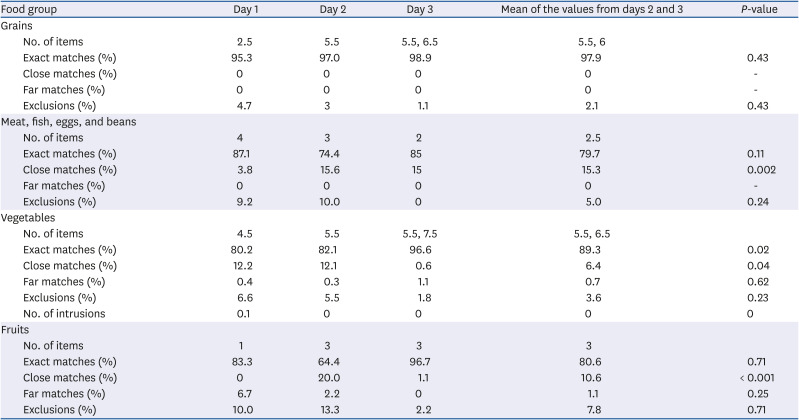
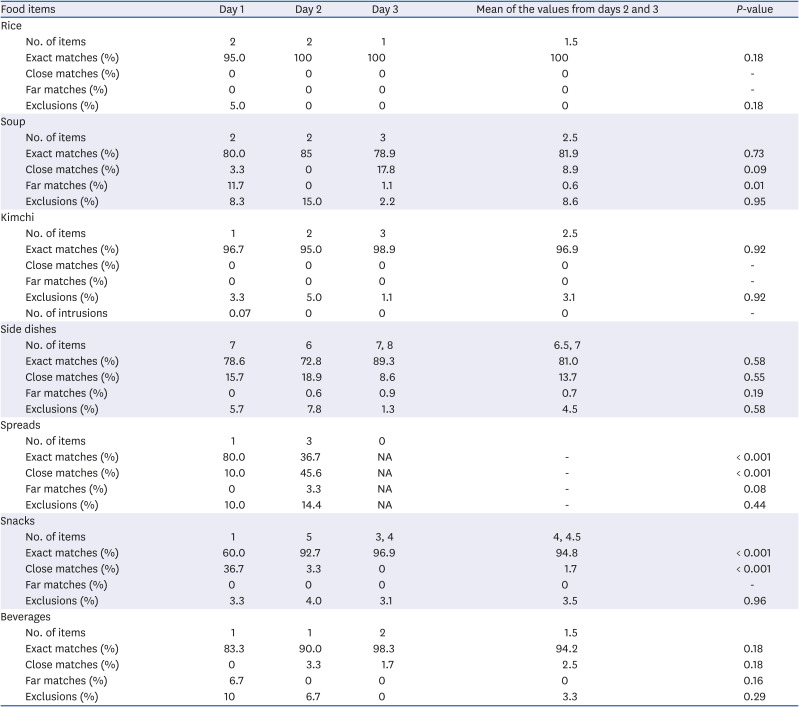

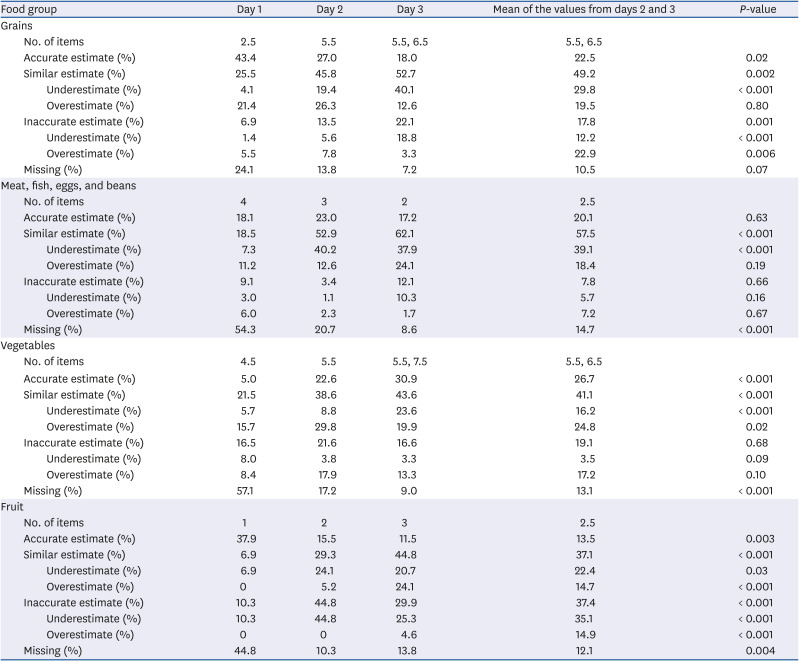
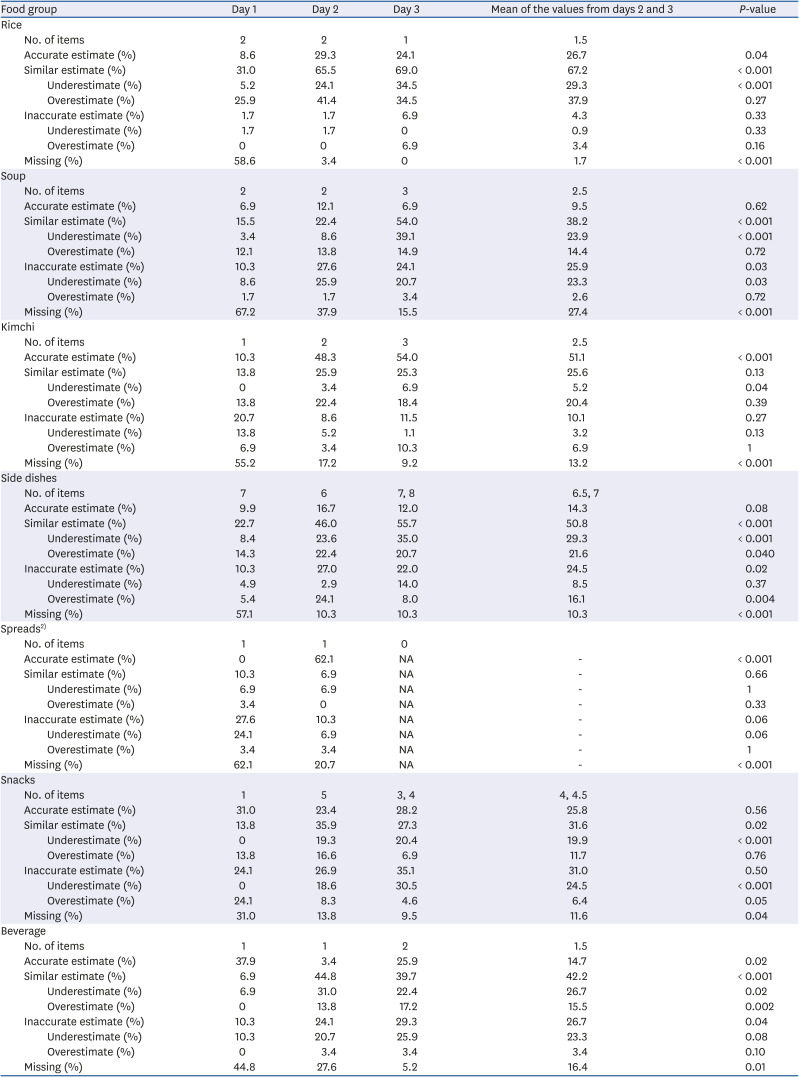




 PDF
PDF Citation
Citation Print
Print



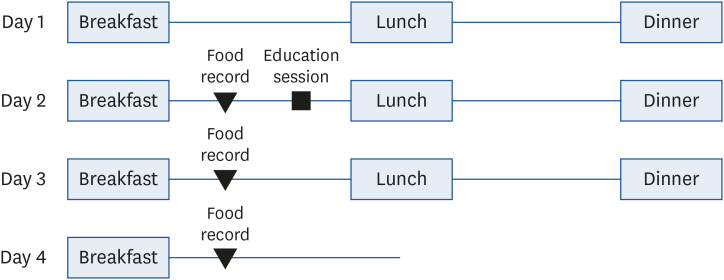

 XML Download
XML Download